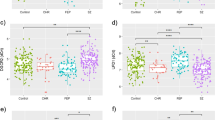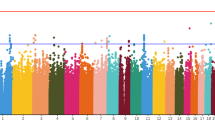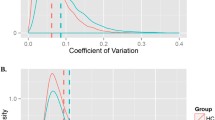Abstract
Schizophrenia (SCZ) is a mental disorder arising from a complex interaction of genetic and environmental factors. It has been suggested that treatment-resistant schizophrenia (TRS) is a distinct, more severe, and homogenous subgroup of schizophrenia that could present specific biological markers. Our aim was to characterize expression of target genes in blood of TRS patients compared with non-TRS (NTRS) patients and healthy controls (HC). TRS has been defined using failure to respond to two previous antipsychotic trials. We hypothesized that genes involved in neurodevelopment, myelination, neuroplasticity, neurotransmission, and miRNA processing could be involved in treatment resistance; then, we investigated 13 genes related to those processes in 256 subjects, being 94 healthy controls and 162 schizophrenia patients treated with antipsychotics. Of those, 78 were TRS patients and 84 were NTRS patients. Peripheral blood samples were collected from all subjects and RNA was isolated. Gene expression analysis was performed using the TaqMan low-density array (TLDA) technology. To verify the influence of expression quantitative trait loci (eQTLs), we evaluated single-nucleotide polymorphism (SNP) of all genes using data from GTEx Project. SNP genotypes were obtained from HumanOmniExpress BeadChip. We did not detect gene expression differences between TRS and NTRS subjects, indicating candidate genes specific to treatment resistance. We detected an upregulation of CNR1 and UFD1L gene expression in patients (TRS and NTRS groups) when compared to controls, that may be associated with the release of neurotransmitters, which can influence neuronal plasticity, or with a stress response-activating protein degradation. DICER1 and AKT1 expression increased slightly across the groups and could differentiate only the extreme opposite groups, HC and TRS. Both genes act in heterogeneous pathways, such as cell signaling and miRNA processing, and seem to have an increased demand in the TRS group. We did not detect any eQTLs in our sample that could explain differences in mRNA levels, suggesting a possible regulation by other mechanism, not driven by genotypes. Our data strengthen the importance of several biological pathways involved in the schizophrenia refractoriness and severity, adding knowledge to develop more effective treatments in the future.

Similar content being viewed by others
References
Owen MJ, O'Donovan MC, Thapar A, Craddock N (2011) Neurodevelopmental hypothesis of schizophrenia. Br J Psychiatry 198(3):173–175. https://doi.org/10.1192/bjp.bp.110.084384
Henriksen MG, Nordgaard J, Jansson LB (2017) Genetics of schizophrenia: overview of methods, findings and limitations. Front Hum Neurosci 11:322. https://doi.org/10.3389/fnhum.2017.00322
Gejman PV, Sanders AR, Kendler KS (2011) Genetics of schizophrenia: new findings and challenges. Annu Rev Genomics Hum Genet 12(1):121–144. https://doi.org/10.1146/annurev-genom-082410-101459
Boyle EA, Li YI, Pritchard JK (2017) An expanded view of complex traits: from polygenic to omnigenic. Cell 169(7):1177–1186. https://doi.org/10.1016/j.cell.2017.05.038
Leucht S, Pitschel-Walz G, Abraham D, Kissling W (1999) Efficacy and extrapyramidal side-effects of the new antipsychotics olanzapine, quetiapine, risperidone, and sertindole compared to conventional antipsychotics and placebo. A meta-analysis of randomized controlled trials. Schizophr Res 35(1):51–68. https://doi.org/10.1016/S0920-9964(98)00105-4
Kapur S, Seeman P (2001) Does fast dissociation from the dopamine d(2) receptor explain the action of atypical antipsychotics?: a new hypothesis. Am J Psychiatry 158(3):360–369. https://doi.org/10.1176/appi.ajp.158.3.360
Kane JM, Honigfeld G, Singer J, Meltzer H (1988) Clozapine in treatment-resistant schizophrenics. Psychopharmacol Bull 24(1):62–67
Taylor DM, Duncan-McConnell D (2000) Refractory schizophrenia and atypical antipsychotics. J Psychopharmacol 14(4):409–418. https://doi.org/10.1177/026988110001400411
McGorry P, Killackey E, Elkins K, Lambert M, Lambert T (2003) Summary Australian and New Zealand clinical practice guideline for the treatment of schizophrenia. Australasian Psychiatry 2(11):136–147
Crespo-Facorro B, de la Foz VO, Ayesa-Arriola R, Perez-Iglesias R, Mata I, Suarez-Pinilla P et al (2013) Prediction of acute clinical response following a first episode of non affective psychosis: results of a cohort of 375 patients from the Spanish PAFIP study. Prog Neuro-Psychopharmacol Biol Psychiatry 44:162–167. https://doi.org/10.1016/j.pnpbp.2013.02.009
Huber CG, Naber D, Lambert M (2008) Incomplete remission and treatment resistance in first-episode psychosis: definition, prevalence and predictors. Expert Opin Pharmacother 9(12):2027–2038. https://doi.org/10.1517/14656566.9.12.2027
Meltzer HY (1999) The role of serotonin in antipsychotic drug action. Neuropsychopharmacology 21(2 Suppl):106S–115S. https://doi.org/10.1016/S0893-133X(99)00046-9
Meltzer HY (1990) Defining treatment refractoriness in schizophrenia. Schizophr Bull 16(4):563–565. https://doi.org/10.1093/schbul/16.4.563
IPAP. The International Psychopharmacology Algorithm Project. 2009 [cited 2017 21/12/2017]; Available from: http://www.ipap.org/schiz/index.php.
Andreasen NC, Pressler M, Nopoulos P, Miller D, Ho BC (2010 Feb 1) Antipsychotic dose equivalents and dose-years: a standardized method for comparing exposure to different drugs. Biol Psychiatry 67(3):255–262. https://doi.org/10.1016/j.biopsych.2009.08.040
Spindola LM, Pan PM, Moretti PN, Ota VK, Santoro ML, Cogo-Moreira H, Gadelha A, Salum G et al (2017) Gene expression in blood of children and adolescents: mediation between childhood maltreatment and major depressive disorder. J Psychiatr Res 92:24–30. https://doi.org/10.1016/j.jpsychires.2017.03.015
Hruz T, Laule O, Szabo G, Wessendorp F, Bleuler S, Oertle L et al (2008) Genevestigator v3: a reference expression database for the meta-analysis of transcriptomes. Adv Bioinforma 2008:420747
Christofolini DM, Bellucco FT, Ota VK, Belangero SI, Cernach MC, Gadelha A et al (2011) Assessment of 22q11.2 copy number variations in a sample of Brazilian schizophrenia patients. Schizophr Res 132(1):99–100. https://doi.org/10.1016/j.schres.2011.07.007
Gillespie AL, Samanaite R, Mill J, Egerton A, MacCabe JH (2017) Is treatment-resistant schizophrenia categorically distinct from treatment-responsive schizophrenia? A systematic review. BMC Psychiatry 17(1):12. https://doi.org/10.1186/s12888-016-1177-y
Anderson VM, Goldstein ME, Kydd RR, Russell BR (2015) Extensive gray matter volume reduction in treatment-resistant schizophrenia. Int J Neuropsychopharmacol 18(7):pyv016
Demjaha A, Egerton A, Murray RM, Kapur S, Howes OD, Stone JM, McGuire PK (2014) Antipsychotic treatment resistance in schizophrenia associated with elevated glutamate levels but normal dopamine function. Biol Psychiatry 75(5):e11–e13. https://doi.org/10.1016/j.biopsych.2013.06.011
Demjaha A, Murray RM, McGuire PK, Kapur S, Howes OD (2012) Dopamine synthesis capacity in patients with treatment-resistant schizophrenia. Am J Psychiatry 169(11):1203–1210. https://doi.org/10.1176/appi.ajp.2012.12010144
Krebs MO, Sautel F, Bourdel MC, Sokoloff P, Schwartz JC, Olie JP et al (1998) Dopamine D3 receptor gene variants and substance abuse in schizophrenia. Mol Psychiatry 3(4):337–341. https://doi.org/10.1038/sj.mp.4000411
Gouvea ES, Santos AFF, Ota VK, Mrad V, Gadelha A, Bressan RA et al (2017) The role of the CNR1 gene in schizophrenia: a systematic review including unpublished data. Rev Bras Psiquiatr 39(2):160–171. https://doi.org/10.1590/1516-4446-2016-1969
D'Souza DC, Abi-Saab WM, Madonick S, Forselius-Bielen K, Doersch A, Braley G et al (2005) Delta-9-tetrahydrocannabinol effects in schizophrenia: implications for cognition, psychosis, and addiction. Biol Psychiatry 57(6):594–608. https://doi.org/10.1016/j.biopsych.2004.12.006
Dinu IR, Popa S, Bicu M, Mota E, Mota M (2009) The implication of CNR1 gene’s polymorphisms in the modulation of endocannabinoid system effects. Rom J Intern Med 47(1):9–18
Okahisa Y, Kodama M, Takaki M, Inada T, Uchimura N, Yamada M, Iwata N, Iyo M et al (2011 Mar) Association study of two cannabinoid receptor genes, CNR1 and CNR2, with methamphetamine dependence. Curr Neuropharmacol 9(1):183–189. https://doi.org/10.2174/157015911795017191
Ujike H, Takaki M, Nakata K, Tanaka Y, Takeda T, Kodama M, Fujiwara Y, Sakai A et al (2002) CNR1, central cannabinoid receptor gene, associated with susceptibility to hebephrenic schizophrenia. Mol Psychiatry 7(5):515–518. https://doi.org/10.1038/sj.mp.4001029
Chavarria-Siles I, Contreras-Rojas J, Hare E, Walss-Bass C, Quezada P, Dassori A et al (2008) Cannabinoid receptor 1 gene (CNR1) and susceptibility to a quantitative phenotype for hebephrenic schizophrenia. Am J Med Genet B Neuropsychiatr Genet 147(3):279–284. https://doi.org/10.1002/ajmg.b.30592
Martinez-Gras I, Hoenicka J, Ponce G, Rodriguez-Jimenez R, Jimenez-Arriero MA, Perez-Hernandez E et al (2006) (AAT)n repeat in the cannabinoid receptor gene, CNR1: association with schizophrenia in a Spanish population. Eur Arch Psychiatry Clin Neurosci 256(7):437–441. https://doi.org/10.1007/s00406-006-0665-3
Hamdani N, Tabeze JP, Ramoz N, Ades J, Hamon M, Sarfati Y, Boni C, Gorwood P (2008) The CNR1 gene as a pharmacogenetic factor for antipsychotics rather than a susceptibility gene for schizophrenia. Eur Neuropsychopharmacol 18(1):34–40. https://doi.org/10.1016/j.euroneuro.2007.05.005
Grissom NM, Herdt CT, Desilets J, Lidsky-Everson J, Reyes TM (2015) Dissociable deficits of executive function caused by gestational adversity are linked to specific transcriptional changes in the prefrontal cortex. Neuropsychopharmacology 40(6):1353–1363. https://doi.org/10.1038/npp.2014.313
Kuntsi J, Frazier-Wood AC, Banaschewski T, Gill M, Miranda A, Oades RD, Roeyers H, Rothenberger A et al (2013) Genetic analysis of reaction time variability: room for improvement? Psychol Med 43(6):1323–1333. https://doi.org/10.1017/S0033291712002061
Johnson KA, Robertson IH, Kelly SP, Silk TJ, Barry E, Daibhis A et al (2007) Dissociation in performance of children with ADHD and high-functioning autism on a task of sustained attention. Neuropsychologia 45(10):2234–2245. https://doi.org/10.1016/j.neuropsychologia.2007.02.019
Ben Shalom D, Ronel Z, Faran Y, Meiri G, Gabis L, Kerns KA (2017) A double dissociation between inattentive and impulsive traits, on tasks of visual processing and emotion regulation. J Atten Disord 21(7):543–553. https://doi.org/10.1177/1087054713510351
Marco EM, Echeverry-Alzate V, Lopez-Moreno JA, Gine E, Penasco S, Viveros MP (2014) Consequences of early life stress on the expression of endocannabinoid-related genes in the rat brain. Behav Pharmacol 25(5–6):547–556. https://doi.org/10.1097/FBP.0000000000000068
D'Addario C, Micale V, Di Bartolomeo M, Stark T, Pucci M, Sulcova A, Palazzo M, Babinska Z et al (2017) A preliminary study of endocannabinoid system regulation in psychosis: distinct alterations of CNR1 promoter DNA methylation in patients with schizophrenia. Schizophr Res 188:132–140. https://doi.org/10.1016/j.schres.2017.01.022
Wilson RI, Nicoll RA (2002) Endocannabinoid signaling in the brain. Science 296(5568):678–682. https://doi.org/10.1126/science.1063545
Bassett AS, Chow EW, Husted J, Weksberg R, Caluseriu O, Webb GD, Gatzoulis MA (2005) Clinical features of 78 adults with 22q11 deletion syndrome. Am J Med Genet A 138(4):307–313. https://doi.org/10.1002/ajmg.a.30984
Ota VK, Belangero SI, Gadelha A, Bellucco FT, Christofolini DM, Mancini TI, Ribeiro-dos-Santos ÂK, Santos SE et al (2010) The UFD1L rs5992403 polymorphism is associated with age at onset of schizophrenia. J Psychiatr Res 44(15):1113–1115. https://doi.org/10.1016/j.jpsychires.2010.04.008
Novelli G, Mari A, Amati F, Colosimo A, Sangiuolo F, Bengala M, Conti E, Ratti A et al (1998) Structure and expression of the human ubiquitin fusion-degradation gene (UFD1L). Biochim Biophys Acta 1396(2):158–162. https://doi.org/10.1016/S0167-4781(97)00211-X
Chen M, Gutierrez GJ, Ronai ZA (2011) Ubiquitin-recognition protein Ufd1 couples the endoplasmic reticulum (ER) stress response to cell cycle control. Proc Natl Acad Sci U S A 108(22):9119–9124. https://doi.org/10.1073/pnas.1100028108
Ye Y, Meyer HH, Rapoport TA (2001) The AAA ATPase Cdc48/p97 and its partners transport proteins from the ER into the cytosol. Nature. [Research Support, Non-U.S. Gov't Research Support, U.S. Gov't, P.H.S.] 414(6864):652–656
De Luca A, Pasini A, Amati F, Botta A, Spalletta G, Alimenti S et al (2001) Association study of a promoter polymorphism of UFD1L gene with schizophrenia. Am J medical Genetics. [Multicenter Study Research Support, Non-U.S. Gov't] 105(6):529–533
Ota VK, Berberian AA, Gadelha A, Santoro ML, Ottoni GL, Matsuzaka CT, Mari JJ, Melaragno MI et al (2013 Aug 30) Polymorphisms in schizophrenia candidate gene UFD1L may contribute to cognitive deficits. Psychiatry Res 209(1):110–113. https://doi.org/10.1016/j.psychres.2013.03.035
Gouvea ES, Ota VK, Noto C, Santoro ML, Spindola LM, Moretti PN, Carvalho CM, Xavier G et al (2016 Oct 04) Gene expression alterations related to mania and psychosis in peripheral blood of patients with a first episode of psychosis. Transl Psychiatry 6(10):e908. https://doi.org/10.1038/tp.2016.159
Santarelli DM, Beveridge NJ, Tooney PA, Cairns MJ (2011) Upregulation of dicer and microRNA expression in the dorsolateral prefrontal cortex Brodmann area 46 in schizophrenia. Biol Psychiatry 69(2):180–187. https://doi.org/10.1016/j.biopsych.2010.09.030
Beveridge NJ, Gardiner E, Carroll AP, Tooney PA, Cairns MJ (2010) Schizophrenia is associated with an increase in cortical microRNA biogenesis. Mol Psychiatry 15(12):1176–1189. https://doi.org/10.1038/mp.2009.84
Sanders AR, Goring HH, Duan J, Drigalenko EI, Moy W, Freda J et al (2013) Transcriptome study of differential expression in schizophrenia. Hum Mol Genet 22(24):5001–5014. https://doi.org/10.1093/hmg/ddt350
Camkurt MA, Karababa F, Erdal ME, Bayazit H, Kandemir SB, Ay ME et al (2016) Investigation of dysregulation of several microRNAs in peripheral blood of schizophrenia patients. Clin Psychopharmacol Neurosci 14(3):256–260. https://doi.org/10.9758/cpn.2016.14.3.256
Alacam H, Akgun S, Akca H, Ozturk O, Kabukcu BB, Herken H (2016) miR-181b-5p, miR-195-5p and miR-301a-3p are related with treatment resistance in schizophrenia. Psychiatry Res 245:200–206. https://doi.org/10.1016/j.psychres.2016.08.037
Balu DT, Carlson GC, Talbot K, Kazi H, Hill-Smith TE, Easton RM, Birnbaum MJ, Lucki I (2012 Feb) Akt1 deficiency in schizophrenia and impairment of hippocampal plasticity and function. Hippocampus 22(2):230–240. https://doi.org/10.1002/hipo.20887
Woodgett JR (2005) Recent advances in the protein kinase B signaling pathway. Curr Opin Cell Biol 17(2):150–157. https://doi.org/10.1016/j.ceb.2005.02.010
Arguello PA, Gogos JA (2008) A signaling pathway AKTing up in schizophrenia. J Clin Invest 118(6):2018–2021. https://doi.org/10.1172/JCI35931
Emamian ES (2012) AKT/GSK3 signaling pathway and schizophrenia. Front Mol Neurosci 5:33
Aubry JM, Schwald M, Ballmann E, Karege F (2009) Early effects of mood stabilizers on the Akt/GSK-3beta signaling pathway and on cell survival and proliferation. Psychopharmacology 205(3):419–429. https://doi.org/10.1007/s00213-009-1551-2
Tan HY, Nicodemus KK, Chen Q, Li Z, Brooke JK, Honea R, Kolachana BS, Straub RE et al (2008) Genetic variation in AKT1 is linked to dopamine-associated prefrontal cortical structure and function in humans. J Clin Invest 118(6):2200–2208. https://doi.org/10.1172/JCI34725
Emamian ES, Hall D, Birnbaum MJ, Karayiorgou M, Gogos JA (2004) Convergent evidence for impaired AKT1-GSK3beta signaling in schizophrenia. Nat Genet 36(2):131–137. https://doi.org/10.1038/ng1296
Karege F, Perroud N, Schurhoff F, Meary A, Marillier G, Burkhardt S et al (2010) Association of AKT1 gene variants and protein expression in both schizophrenia and bipolar disorder. Genes Brain Behav 9(5):503–511. https://doi.org/10.1111/j.1601-183X.2010.00578.x
van Beveren NJ, Buitendijk GH, Swagemakers S, Krab LC, Roder C, de Haan L et al (2012) Marked reduction of AKT1 expression and deregulation of AKT1-associated pathways in peripheral blood mononuclear cells of schizophrenia patients. PLoS One 7(2):e32618. https://doi.org/10.1371/journal.pone.0032618
Casseb SM, Simith DB, Melo KF, Mendonca MH, Santos AC, Carvalho VL, Cruz ACR, Vasconcelos PFC (2016) Drosha, DGCR8, and Dicer mRNAs are down-regulated in human cells infected with dengue virus 4, and play a role in viral pathogenesis. Genet Mol Res 15(2). https://doi.org/10.4238/gmr.15027891
Dambal S, Giangreco AA, Acosta AM, Fairchild A, Richards Z, Deaton R, Wagner D, Vieth R et al (2017) microRNAs and DICER1 are regulated by 1,25-dihydroxyvitamin D in prostate stroma. J Steroid Biochem Mol Biol 167:192–202. https://doi.org/10.1016/j.jsbmb.2017.01.004
Meltzer HY, Rabinowitz J, Lee MA, Cola PA, Ranjan R, Findling RL, Thompson PA (1997 Apr) Age at onset and gender of schizophrenic patients in relation to neuroleptic resistance. Am J Psychiatry 154(4):475–482. https://doi.org/10.1176/ajp.154.4.475
Lieberman JA, Safferman AZ, Pollack S, Szymanski S, Johns C, Howard A, Kronig M, Bookstein P et al (1994) Clinical effects of clozapine in chronic schizophrenia: response to treatment and predictors of outcome. Am J Psychiatry 151(12):1744–1752. https://doi.org/10.1176/ajp.151.12.1744
Quintero J, Barbudo del Cura E, Lopez-Ibor MI, Lopez-Ibor JJ (2011) The evolving concept of treatment-resistant schizophrenia. Actas Esp Psiquiatr 39(4):236–250
Author information
Authors and Affiliations
Corresponding author
Ethics declarations
The Research Ethics Committee of UNIFESP approved the study, and all the participants and family members provided written informed consent prior to enrolment in the study (CAAE 06191612.7.0000.5505).
Rights and permissions
About this article
Cite this article
Moretti, P.N., Ota, V.K., Gouvea, E.S. et al. Accessing Gene Expression in Treatment-Resistant Schizophrenia. Mol Neurobiol 55, 7000–7008 (2018). https://doi.org/10.1007/s12035-018-0876-4
Received:
Accepted:
Published:
Issue Date:
DOI: https://doi.org/10.1007/s12035-018-0876-4




